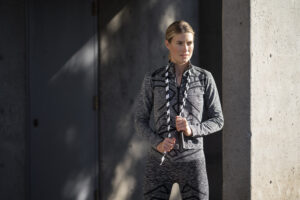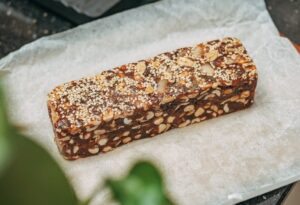Getting fit, losing weight quickly and healthily, building muscle: there are countless apps, wearables, fitness trackers, smartwatches, and promises out there. However, there is not a single solution that can do everything. All products are merely individual pieces of a puzzle in the bigger picture. And unfortunately, even in 2022, no matter how technologically advanced they are, these gadgets are unable to take care of your sweating regime and help you stick to your workout and diet plans. We’ll show you how the individual pieces all fit together and how to get fit with apps and gadgets in the best possible manner.
The last two years have put all good habits to the test, especially in terms of fitness. My membership at Urban Sports Club has been cancelled, and I haven’t seen the insides of a gym in what is now a year and a half. And as things happen, it is a slow but surely slippery slope downwards.
Instead of regularly squeezing into an EMS suit, I learned how to make really good pizza at home (thanks for the recipe pounds, Vito Iacopelli) and even bought myself a pizza oven with the Ooni Koda 16. Well, due to a lack of options, three pizza evenings a week come up quickly as you have to practice to obtain the perfect dough!
Affiliate offer
Ooni Koda 16
Check Offer
$599.00
(Amazon)
At the very least, the big munchies have another opponent at the beginning of 2021. As part of our NextFit challenge, I’ve been exercising regularly once again, and am now quite fit again as the year draws to a close. But what does “fitness” actually involve and how do gadgets help us get healthier and fitter?
Jump to
Hello evolution: How can I lose weight (fast)?
The calorie balance: Calorie intake and calorie consumption
Counting calories is important: How it works
Estimating calorie consumption: Fitness Tracker and other devices
Sports as a calorie driver
Sports for health
There are books that contain just about every aspect of fitness, and there is only enough space here to touch on all aspects. I would therefore like to show you in a holistic manner as far as possible, my learnings from a decade of fitness enthusiasm including a fitness trainer B license, even if I admittedly still lack the glory of acing the final exam.
1. Lose weight fast? Evolution is an blockhead
Blame evolution for the fact that we can’t just slouch on the couch all day long and shovel fast food into our mouths without a care in the world, because the body is a machine that has perfected over the course of evolution. The appetite is only surpassed by the fact that successful reproduction is key to our survival and our great goal, where until the age of supermarkets, lack of food was the greatest threat for thousands of years.
Therefore, any excess energy is meticulously stored as fat during times of crisis. Because of their genetic heritage, every human being has different predispositions as to where and, above all, how much fat is stored in the body. Your ancestors had to fight hard for survival? Too bad for you, because your body is probably now even more effective at hoarding flab.
Aerial view of Nauru
Not-so-fun fact: Centuries of food shortages and the sudden rise of wealth from bird poop gave Nauru the world’s highest rate of diabetes. / © Atmospheric Radiation Measurement Program
In addition to genetic predisposition, metabolic training also plays a role. For example, those who starve themselves of food on crash diets train their metabolism to hoard even more calories in the form of fat. What this has to do with the yoyo effect, you can read further below.
2. Your body weight: intake and consumption
Regardless of your genetic makeup, the basic idea behind weight loss and weight gain is simple: if you eat more calories than burn them, you gain weight. The same logic applies the other way around, allowing you to lose weight. Yes, there are countless trends like: “no more carbs after 6 p.m.”, interval fasting, low carb high-fat diets, or some insane stuff from Gwyneth Paltrow. Some of it is just useless at best, other measures actually push your metabolism in a different direction in the long run or help you develop healthier eating habits in general which helps you lose weight.
In my experience, however, the chance of success is much higher if you view your body as a self-contained physical system, and that’s where the input-output principle applies. The very first step is to get to know your calorie intake (input) and your consumption (output).
2.1 Input: Counting calories is a birdbrain
Yes, writing down all your meals and drinks rivals sorting screws or watching paint dry in terms of popularity. However, doing so is essential. In addition, there are numerous apps that make the endeavor a whole lot easier.
Instead of typing out the calorie content, fat, etc. of your sandwich, you can simply scan the barcode on the packaging with the likes of Fatsecret, for instance, and have your lunch noted. Also, if you keep up with the nutrition tracking for the next few weeks, you will quickly develop a very good feeling about your nutrition and learn to listen to your body at the same time.
MG 9291
You can use smartwatches and fitness trackers to record your calorie consumption. This will help achieve your goals! / © NextPit
In addition to pure energy intake in terms of kilocalories, most apps also record the macronutrients that make up the amount of energy you consume. The macronutrients comprise of fat, protein, and the sometimes called “carbs.” Bad news for those who love their drinks. Alcohol, by the way, is also a macronutrient and has hefty calories. Two shot glasses of absinthe are roughly equivalent to one shot glass of olive oil. Yum!
Macronutrients in comparison
Carbohydrates
Protein Fat Alcohol
4 kcal/g 4 kcal/g 9 kcal/g 7 kcal/g
Whether it is low-carb or high-carb, there are countless philosophies on how the supplied energy should ideally be composed of macronutrients. While the composition has no or only a secondary influence on weight gain or loss (depending on the source of information), it still plays a role for the body. For example, I feel tired all the time on low-carb diets because my body is missing this easily available energy source in carbohydrates. Add that to having wrong meals at the wrong time, you just tend to eat too much.
apple scan fatsecret
With Fatsecret you can also take photos of food in order to record the calorie content / © NextPit
I’ve always done best with a macronutrient ratio between 60:20:20 and 80:10:10, respectively, based on carbs to proteins to fats as proportional energy sources. If you track your diet for a while, you’ll see the distribution of macronutrients in the apps and learn for yourself what works best for you.
In my opinion, the best app for calorie counting is Cronometer. Here you can track not only the macronutrients mentioned above, but also the micronutrients, i.e. vitamins, trace elements, etc. In the following article, you can read a more detailed comparison of popular calorie counter apps:
The best free calorie counter apps compared
Calorie counting apps: Our favorites
App Short description Link
CronometerCronometer tracks not only macro- but also micronutrients. Even if the database did not recognize Nutella in our test, it still recognizes most of the foods. What’s also great is how Cronometer has a browser version, letting you comfortably check your nutrition history on a large display. The Pro functions such as meal photos and detailed analyses cost a good $29.99 annually.
Android
iOS
FDDB ExtenderThe Food Database is the dinosaur among databases for food, nutrients & others, and with FDDB Extender, it arrives as an app on your smartphone. The range of functions is very similar to Cronometer. A few additional functions such as goals for macronutrients comes at a small monthly fee. Optionally, the app can also be connected to Google Fit, Samsung Health, Fitbit, or Garmin Connect.
Android
iOS
For the lack of space in this digital magazine, here is a side note: Away from macronutrients, there is still an enormous amount of information to consider nutritionally. “Fast carbs” are (usually) worse than “slow carbs” (keyword: glycemic index), there are good and bad fats (keyword: saturated/unsaturated), and there are also huge differences in protein (keyword: value).
Oatmeal (slow carbs), for example, makes you feel full much longer than white toast (fast carbs), and this simply makes it easier to eat less. There is a lot of literature on this subject, and I am sure you will quickly find what you are looking for at your local bookstore or in the relevant forums.
2.2 Output: How to estimate calorie consumption
After you have determined the input, it’s time for output. This is made up of two parts: the so-called basal metabolic rate and the power metabolic rate. The basal metabolic rate quantifies how much energy you consume while oxidizing in everyday life without involving sports or shopping trips, which are pretty hard to come by because of the pandemic anyway. There are simple rules of thumb and calculators for the basal metabolic rate.
The power metabolic rate finally quantifies the entire “on top” consumption from endless pizza dough kneading to the HIIT sports unit. Fitness trackers are a great help in determining power metabolic rate. They record your daily movements and heart rate and can thus estimate your active calorie consumption reasonably well. You can read more about calorie consumption here:
Related: Calorie counting with a smartwatch and fitness tracker
Fitness trackers and smartwatches: Three recommendations
Device Short description Price/Link
Honor Band 6 (review)
The Honor Band series is unbeatably cheap. For just under $50, this fitness tracker that is released annually records your sleep, heart rate, or even the oxygen saturation in the blood. And in the Honor Band 6, the display has finally become really big. The smartphone app Huawei Health sees action here as it offers nicely prepared data and even a few successful training plans. The price-performance ratio is amazing as well!
Honor Band 6
Apple Watch Series 7
(review)
Of course, this question hardly arises for iPhone users. We will still want to answer it: The Apple Watch Series 7 is a great fitness smartwatch that not only connects to the iPhone, but also with Bluetooth chest straps and others. In combination with Apple Fitness+ it is a great choice if you want to work on your fitness in the coming year.
Apple Watch Series 7
Samsung Galaxy Watch 4
(Review)
On the opposite end of the Apple Watch Series 7 spectrum is the Samsung Galaxy Watch 4 for Android users. Hardly any other smartwatch offers so many sensors and features which can sometimes even seem overwhelming. If you want a full-featured smartwatch with detailed tracking features, then you should take a closer look at this model.
Samsung Galaxy Watch 4
For more fitness trackers and smartwatches to monitor your calorie consumption, check out the articles linked below. If you don’t want to buy additional hardware, pedometer apps will help – they let you estimate your energy expenditure using your smartphone. Sports units, however, can not be recorded as accurately due to the lack of pulse measurement.
The best fitness trackers for Android and iOS
The best smartwatches for Android and iOS
The best pedometer apps in comparison
3. Sport as a calorie driver: Consumption versus input
If you now know the input and the consumption, then weight gain or loss should result from this. In reality, this is unfortunately not quite as simple, as the body is an extremely complex system with values for calorie consumption being always mere estimates. But you can improve the degree of accuracy: Log your weight for a few weeks; either with analog scales and pen or in a more convenient manner, use smart scales that are connected to your smartphone app. If there are inconsistencies, you can then adjust your basal metabolic rate as determined by rule of thumb.
Or you can finally stop sneaking all those chocolate bars past the calorie counter.
MG 9139
Muscles that you do not use regularly are considered useless by your body / © NextPit
Now, if you’re putting on or losing weight, there’s another variable: How much exercise are you doing and how much stress is your body experiencing? This is where the aforementioned evolution comes into play, because muscles are a luxury for your body from an evolutionary point of view. When at rest, they consume a lot of valuable energy and are therefore broken down if they are not absolutely necessary for survival – i.e. constantly being used.
This is especially true for the calorie deficit: If you don’t exercise when you have a negative calorie balance, your body will then panic and not only turns to your fat stores for energy reserves, but even prefers to use your muscles as an energy source. After all, they need energy themselves and make survival even more difficult during a long period of starvation. Evolutionarily speaking, it’s better for your body to hold on to the fat.
google fit
Google is trying to unify data from multiple sources with its Fit app. Unfortunately, due to a lack of support from all providers, this doesn’t always work out so well / © NextPit
If you were to eat again after a sportless crash diet as before, the body that is relieved of many muscles has a lower basal metabolic rate than before. With the usual energy intake and still without exercise, you then gain weight again by leaps and bounds. It will be primarily fat this time around, as the next famine could be just around the corner! This harmful weight fluctuation is known as the yo-yo effect.
If, on the other hand, you exercise vigorously in a calorie deficit, your body considers muscles important for survival – and tends to draw more on your fat reserves for energy. Similarly, if you have a calorie surplus plus exercise, you will build more muscle than fat. In traditional bodybuilding, for example, many athletes alternate between so-called “bulk” and “cut phases”, in which muscles are built up first in excess and then the fat added during the course of this is trained off again in a calorie deficit.
Body fat scales: Three recommendations
Device Brief description Link
Huawei AH100The absolute basic model among the body fat scales is the Huawei AH100. The scale is regularly available for less than $50 and records the most important body data including body fat percentage and muscle mass. Convenient for those who use a fitness tracker from Huawei or Honor as the data ends up in the same app.
Huawei AH100
Withings Body+The Withings Body+ connects to the home WLAN. To record your values for body fat, muscle mass, bone density, water percentage, etc., you only have to stand on the scale and watch the rest of the magic happen automatically. Afterward, you can look up relevant data in the app. The Withings Body+ costs around $80.
Withings Body+
Tanita BC-545N
More sophisticated body fat scales like the Tanita BC-545N also offer the possibility to measure the tissue composition of the upper body thanks to a removable handpiece. This allows for more accurate statements about actual body fat percentage(s), muscle mass, etc. However, it comes at a price: the Tanita scale costs just under $200.
Tanita BC-545N
4. The right sport is more than just a calorie driver!
Of course, it’s great to use sport to boost calorie consumption, build muscles up and shrink fat reserves. After all, it contributes enormously to the overall degree of satisfaction when you feel good about your appearance. However, exercise has far more benefits than just lowering your body fat.
MG 9268
Exercise isn’t just about losing weight. Flexibility plays also an important role / © NextPit
All endurance sports, for example, not only drive up calorie consumption, but also strengthen the cardiovascular system, lower your resting heart rate, and reduces your blood pressure. Plus, endurance sports usually force you to put your smartphone down and clear your head for a change. Speaking of which, here are some tips to detox digitally:
Digital detox: 5 effective ways to help you get started
However, most endurance sports only engage the lower half of the body. For those who tend to sit in front of screens for a long time, it’s hugely important to exercise the shoulders and back. Whether you feel more comfortable on a yoga mat or performing full-body HIIT sessions doesn’t matter. What is important is a holistic workout that includes proper stretching. After going through shoulder surgery and a herniated disc, I can relate to this.
puma fitness app
Fitness apps like this one from Puma show how you can do these exercises with well-produced videos / © NextPit
And very important: If you begin to exercise after a long abstinence, do observe yourself at least a few times to ensure correct execution of the exercises in order to avoid injury. For example, by sports-loving friends or a personal trainer (also available via video call) might be able to help. If you have any injuries or illnesses, it’s also better to talk to your doctor beforehand, because you can suffer from serious injuries simply by executing the exercises wrongly.
Source: https://www.nextpit.com/get-fit-with-apps-and-gadgets
- https://www.nextpit.com/
- Smartphone
- United States









